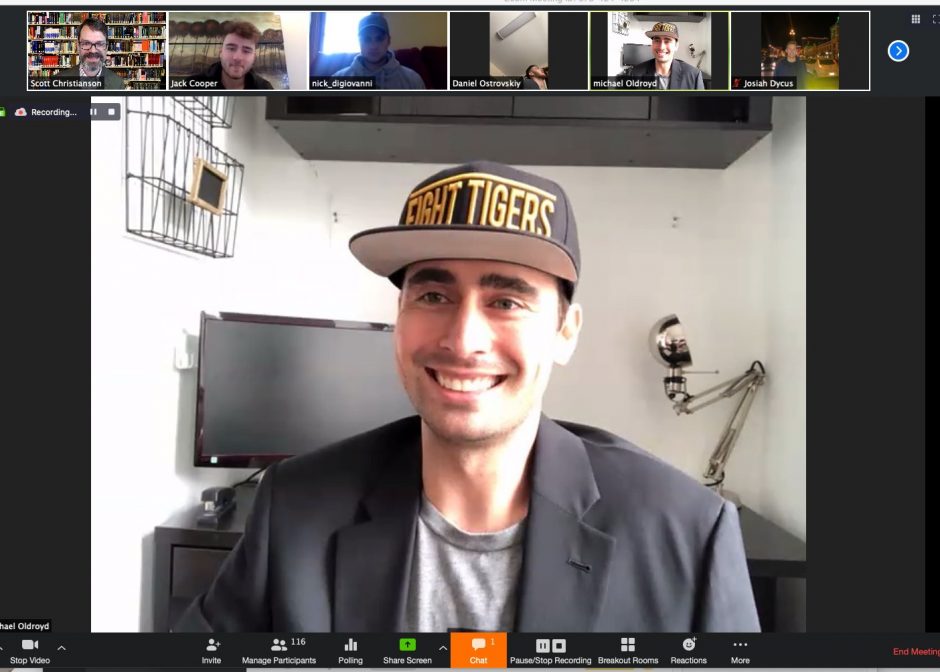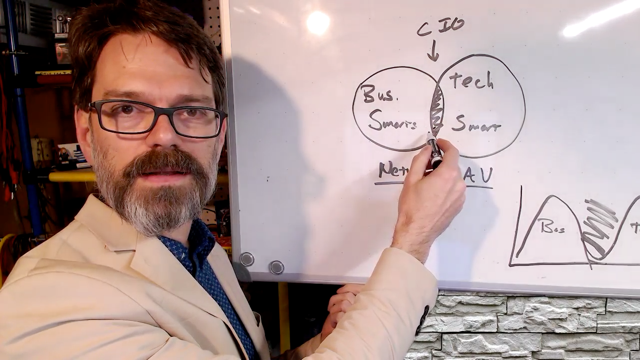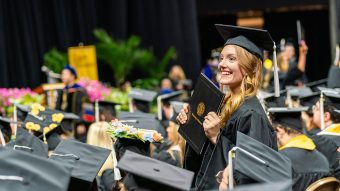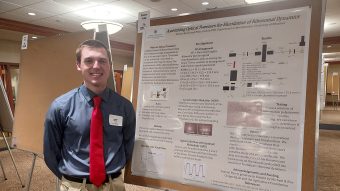April 8, 2020
Contact: Pate McCuien, 573-882-4870, mccuienp@missouri.edu
The transition to remote learning has placed teachers in unfamiliar territory, and many are puzzling out how to keep students engaged in online presentations. However, with a background in video teleconferencing, Trulaske College of Business Assistant Teaching Professor J. Scott Christianson has developed practices to improve student engagement in his classes during these abnormal times. Most recently, Christianson shook things up in one of his online classes with a bit of comedy and the popular video game Minecraft.
For Christianson’s first online session of his Business Processes and Technologies class, he invited Michael Oldroyd, comedian and University of Missouri alum, to open his class with a 10-minute comedic set. The idea came to him as not only a way to draw student engagement but, also, as a stress reliever.
“I think we were all very stressed, so I invited him to provide my class with a 10-minute set,” Christianson said. “It was a great way to think about something else for a little while. It was also a non-threatening way to get used to the technology.”

Once the students were engaged, Oldroyd talked about creating a well-tested product and the business of comedy. He also discussed how his work at a few startups prior to entering the field of comedy helps him sell his comedic product. Christianson says Oldroyd’s experience with working from home was also valuable and timely as well.
“Michael also talked about what it’s like to work from home,” Christianson said. “He talked about how important it is to set a schedule, put on actual work clothes and go to a different room where you can do your work. In the situation we find ourselves today, these were very important conversations to have with our students.”
Another example of Christianson’s creativity while teaching can be seen in his Project Management class. Using Lego bricks, Christianson typically assigns his students to build a city out of Legos using a methodology called SCRUM to practice streamlining productivity. In his “in-person” classes, Christianson would normally have had his students assign roles and create a backlog to assist the creation of the Lego city.
However, after the move to remote classes, he shifted the Lego project to a popular video game, Minecraft. Here, students still must build the city the same way they would with the Lego bricks, but with Minecraft the students will be able to build the city and learn the methodology all from within the safety of their homes.
Following their class assignment of Minecraft, Christianson is requiring his students to collaborate and write a “how-to” guide for other professors wanting to complete this project remotely. Creative assignments such as this add layers that students can relate to elements of their personal lives.

“Learning is a social process,” Christianson said. “You have to try to keep that high level of social engagement because it’s not just about the information that you are trying to convey. It’s really about relating that to students’ lives.”
Christianson has a large amount of experience with remote online meetings. He was the founder and owner of Kaleidoscope Videoconferencing, a specialized videoconferencing consulting and training company, for over 21 years. After enjoying his time as a part-time teacher for several years, he began teaching fulltime in 2014 and, since then, has been experimenting with ways to bring active learning into his classrooms.
Christianson uses both “synchronous” and “asynchronous” distance learning tactics. Synchronous learning takes place when both the students and the teacher are online together at the same time. Asynchronous learning takes place when the professor posts material online and students can learn without being online at the same time as the professor. He said embracing a combination of practices can make classes more interesting.
The professor uses a combination of these tactics in his lesson plans to create an atmosphere of openness and engagement in his classes whether they are remote or in person.

MU student Ryan Bolden is taking Christianson’s Business Processes and Technologies class. He says that Christianson is handling the adjustment to remote teaching well.
“When professors lack the ability to communicate with students, it can be confusing because professors often have a different way of doing things.” Bolden said. “Christianson is doing a good job of remotely communicating what he needs from us, and it’s helping him teach us these counterintuitive and technical skills.”
Christianson’s success wasn’t built in one day. He often looks outward for ideas to improve his classes. Christianson recommends the following actions for teachers trying to improve their online presentation skills while working remotely:
- Ask other students and other professors for help. Talking to peers at your institution or at other institutions can help presenters come up with more creative ideas.
- Learn about the technology. There are all kinds of ways that people can utilize technology to build creative lesson plans. Learning the features of any particular application can expand the capabilities a presenter has while conducting their presentation.
- Make a someone a co-host to help ease struggles with the software. They can help manage the workload of teaching online while watching for chat messages, etc. It is always good to have a second pair of eyes when trying to diagnose issues.
- Test equipment and ideas with colleagues before the presentation. By testing and practicing, presenters can locate any issues before it is time to do the real thing.



